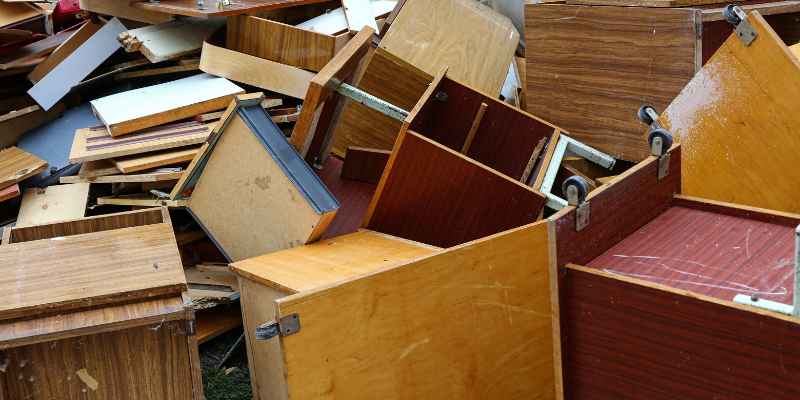Yes, wood can be recycled to create new products or be converted into energy. Wood recycling helps reduce waste and conserve natural resources.
Wood is a versatile and widely used material in various industries. From construction to furniture, it plays a crucial role in our daily lives. However, with the increasing concern for the environment, the question arises: can wood be recycled? In short, yes, wood can be recycled and given a new lease of life.
Recycling wood not only helps reduce the amount of waste sent to landfills but also conserves natural resources. By reusing wood and converting it into new products or energy, we can significantly contribute to sustainability efforts. We will explore the process of wood recycling, its benefits, and the industries that benefit from this eco-friendly practice.
The Importance Of Wood Recycling
Wood recycling is vital for environmental sustainability. It reduces the demand for new timber, prevents deforestation, and minimizes waste in landfills. By recycling wood, valuable resources can be conserved and the carbon footprint reduced.
Wood recycling plays a crucial role in environmental sustainability and conservation of resources. With the growing concern over climate change and the depletion of natural resources, it is essential to understand the significance of recycling wood.
Environmental Impact
Wood recycling has a positive impact on the environment in several ways. Firstly, it helps reduce deforestation by utilizing recycled wood instead of cutting down more trees. Trees, as we know, are vital for carbon sequestration and maintaining a healthy ecosystem. By recycling wood, we can contribute to the fight against climate change by preserving our forests.
Secondly, recycling wood helps reduce landfill waste. Wood is a biodegradable material, but when it ends up in landfills, it decomposes without access to oxygen and produces methane, a potent greenhouse gas. By diverting wood waste from landfills and utilizing it for other purposes, we can minimize methane emissions and create a more sustainable waste management system.
Conservation Of Resources
Wood is a valuable resource, and recycling it helps conserve natural resources in multiple ways. Firstly, recycling wood reduces the demand for virgin timber, which in turn helps protect forests from excessive logging. This not only preserves habitats for various species but also maintains the overall balance of our ecosystems.
Furthermore, recycling wood decreases the need for new wood production. The wood manufacturing process consumes considerable amounts of energy and water, contributing to greenhouse gas emissions and water scarcity. By recycling wood and reusing it in the production of new products or energy generation, we can lower our carbon footprint and help conserve these valuable resources.
In summary, wood recycling plays a vital role in promoting sustainability and resource conservation. By reducing deforestation, minimizing landfill waste, and conserving natural resources, we can make a positive impact on the environment. Embracing wood recycling is not only beneficial for the planet but also for future generations who rely on these resources.

Challenges In Wood Recycling
Wood recycling poses several challenges, but it is indeed possible. The process involves sorting, contamination removal, and converting waste wood into new products, reducing the demand for fresh timber.
Wood recycling offers numerous environmental benefits, reducing the demand for virgin timber and diverting waste from landfills. However, the process is not without its challenges. In this section, we will explore the hurdles faced in wood recycling, including contamination and economic viability.
Contamination:
Contamination poses a significant challenge in wood recycling. Wood recovered from construction sites and demolition projects often contains impurities such as nails, screws, and chemical residues. These contaminants not only affect the quality of recycled wood but also pose risks to equipment and workers involved in the recycling process.
To mitigate contamination issues, stringent sorting and screening procedures are necessary. Specialized machinery is employed to remove metal components, while effective washing techniques help eliminate chemical residues. This ensures that the recycled wood meets the required quality standards and can be utilized in various applications with confidence.
Economic Viability:
Economic viability can also be a major obstacle in wood recycling. Compared to other recyclable materials, the cost of collecting and processing wood waste can be substantial. The expenses involved in transportation, sorting, and treating contaminated wood significantly affect the overall feasibility of wood recycling initiatives.
Wood recycling businesses often face the challenge of finding markets for their recycled wood products. While reclaimed wood is valued for its unique character and environmental benefits, competition from cheaper alternatives, such as composite materials, can make it difficult to establish a profitable market position.
To address economic challenges, partnerships between recycling facilities, manufacturers, and construction industries can provide valuable support. Collaborative efforts can help develop effective channels for the distribution and utilization of recycled wood products, making the ventures economically viable in the long run.
Methods Of Wood Recycling
Wood recycling is a crucial aspect of sustainable waste management. Various methods are employed to recycle wood, allowing it to be given a new lease of life rather than being disposed of in landfills. Here are the methods of wood recycling:
Mechanical Recycling
Mechanical recycling involves breaking down wood into smaller pieces or particles, which are then used to create new wood products. This can be achieved through processes such as chipping, shredding, grinding, and milling. The resulting wood chips or particles can be used in the production of composite wood materials, animal bedding, landscaping mulch, and other applications.
Chemical Recycling
Chemical recycling of wood involves using solvents, heat, and other chemical processes to break down the wood into its constituent components, such as cellulose, lignin, and hemicellulose. These components can then be used to produce new materials, such as biofuels, adhesives, and other chemical products. Chemical recycling offers a way to extract value from wood that may not be suitable for mechanical recycling.
Innovations In Wood Recycling
Wood recycling has seen impressive innovations, making it possible to recycle wood effectively. With advancements in technology, wood can be repurposed and reused, reducing waste and promoting sustainability in the construction industry.
Advanced Technologies
When it comes to the recycling of wood, advanced technologies have emerged as a game changer. These technologies have significantly improved the efficiency and effectiveness of wood recycling, paving the way for a more sustainable future.
- Pyrolysis: One such advanced technology is pyrolysis, a process where wood waste is heated in the absence of oxygen. This leads to the decomposition of the wood into bio-oil, biochar, and syngas. The bio-oil can be used as a renewable fuel, while biochar finds applications in agriculture as a soil amendment. Syngas, on the other hand, can be utilized as a source of renewable energy.
- Wood-plastic composites: Another innovation is the use of wood-plastic composites. These composites are formed by combining waste wood fibers with plastic polymers, creating a durable and environmentally-friendly material. Wood-plastic composites have a wide range of applications, from decking and fencing to furniture and automotive components.
- Advanced sorting systems: Advanced sorting systems have also revolutionized wood recycling. These systems utilize technologies such as near-infrared (NIR) spectroscopy and laser detection to accurately sort different types of wood waste, ensuring that it is sent for the appropriate recycling processes.
Collaborative Initiatives
In addition to advanced technologies, collaborative initiatives have played a crucial role in promoting the recycling of wood waste. These initiatives bring together various stakeholders, including government agencies, recycling companies, and environmental organizations, to work towards common goals.
- Public-private partnerships: One form of collaborative initiative is the establishment of public-private partnerships. These partnerships provide the necessary funding and resources to develop and implement wood recycling programs on a larger scale.
- Industry cooperation: Industry cooperation is also key in driving wood recycling efforts. By sharing knowledge, best practices, and technologies, different companies within the wood industry can work together to optimize recycling processes and minimize waste.
- Education and awareness campaigns: Finally, education and awareness campaigns are instrumental in promoting the importance of wood recycling among the general public. These campaigns aim to educate individuals about the environmental benefits of recycling wood and encourage them to participate in recycling programs.
Benefits Of Sustainable Wood Recycling
Wood can be recycled to create sustainable building materials and reduce environmental impact. Recycling wood helps preserve forests, reduces waste in landfills, and minimizes the need for new raw materials, making it a cost-effective and environmentally friendly option for construction and manufacturing.
Sustainable wood recycling offers numerous benefits for both the environment and the economy. By embracing sustainable practices in wood recycling, we can significantly reduce deforestation and make a positive impact on the circular economy. Let’s explore some of the major advantages below:
Reduced Deforestation
One of the primary benefits of sustainable wood recycling is the significant reduction in deforestation. By recycling wood products, we are actively reducing the demand for new timber, which in turn reduces the need to cut down additional trees. This reduction in deforestation has far-reaching environmental benefits, including:
- Preserving natural habitats and biodiversity
- Preventing soil erosion and maintaining water quality
- Reducing greenhouse gas emissions and combatting climate change
Sustainable wood recycling plays a crucial role in conserving our forests and ensuring their long-term sustainability.
Circular Economy Impact
The concept of a circular economy revolves around minimizing waste and promoting the continual re-use of resources. Sustainable wood recycling aligns perfectly with this idea, as it allows us to utilize wood products more efficiently and extend their lifespan. By incorporating wood recycling into the circular economy, we can:
- Reduce the amount of waste sent to landfills
- Lower the demand for virgin materials
- Minimize energy consumption and associated carbon emissions
Furthermore, integrating wood recycling into the circular economy stimulates job creation and fosters sustainable economic development. It not only reduces the environmental impact but also offers economic benefits for industries involved in the wood recycling process.
Overall, sustainable wood recycling provides a multitude of benefits, including decreased deforestation rates and a positive impact on the circular economy. By making conscious choices to recycle wood products, we can contribute to a greener, more sustainable future for our planet.

Frequently Asked Questions Of Can Wood Be Recycled
Can I Put Wood In My Recycling Bin?
No, wood cannot be put in your recycling bin. Wood is typically considered a bulky item that needs to be disposed of separately. Check with your local waste management services for proper disposal options.
Is Wood Fully Recyclable?
Yes, wood is fully recyclable. It can be broken down and repurposed for various projects and products.
How Do You Recycle Used Wood?
Recycling used wood involves sorting and separating it from other materials. After that, it can be processed into mulch, wood chips, or burned for energy. Companies can also upcycle it into furniture or other products. Be sure to follow local recycling guidelines.
What Woods Cannot Be Recycled?
Woods that cannot be recycled include treated or painted wood, plywood, and particleboard due to the potential for contaminants. These woods should be disposed of separately to avoid harming the environment.
Conclusion
In the quest for sustainability, recycling wood is a crucial practice. By understanding the benefits and methods of wood recycling, we can contribute to reducing waste and protecting our environment. It is evident that wood can be effectively recycled and repurposed to create a more sustainable future for generations to come.


